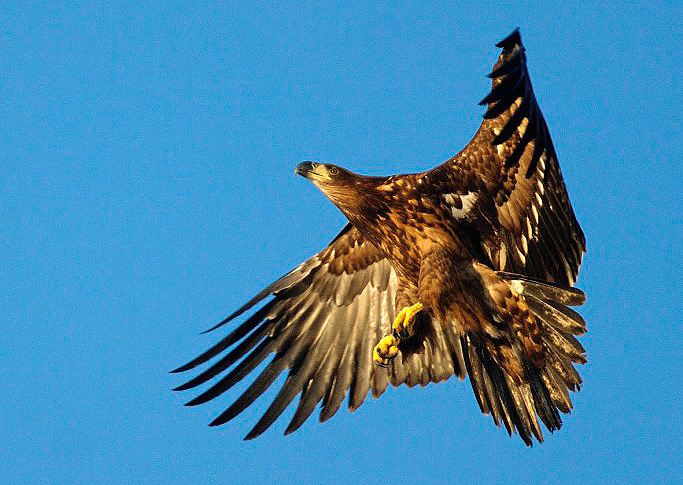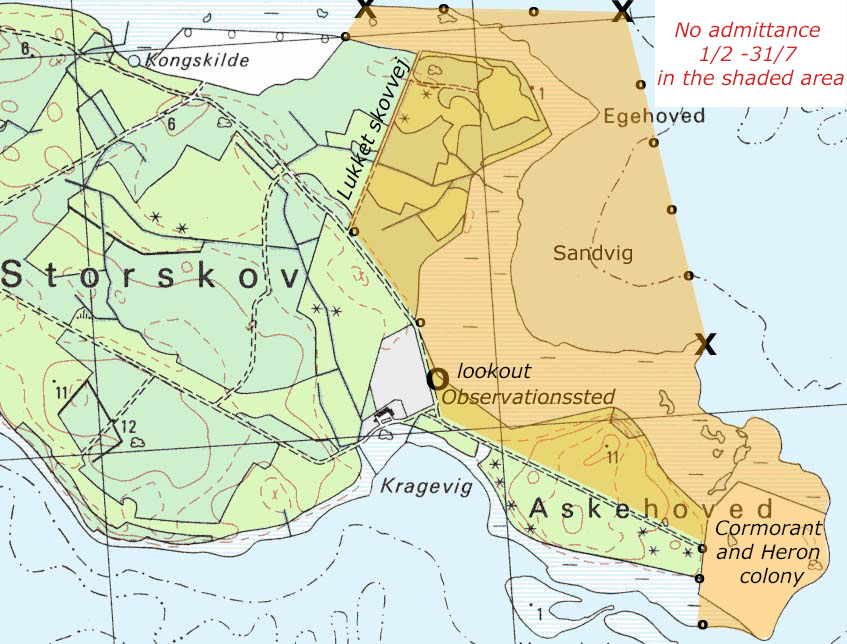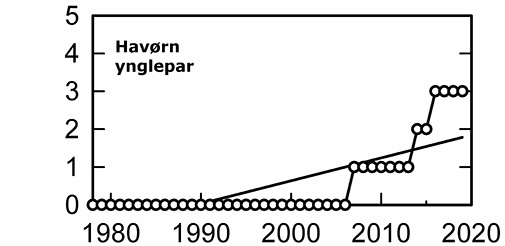White-tailed Eagle
(Haliaeetus albicilla).

A young White-tailed Eagle. Foto: John Larsen.
The White-tailed eagle is a recent addition to the fjord’s breeding birds. It had not bred in this area for 100 years but after the turn of the century it became an increasingly frequent winter guest and in hard winters there have been more than ten eagles here at once. In 2006 a pair of White-tailed Eagles settled as all-year residents on Bognæs and in 2007-2009 they raised their young in a nest that could be observed from a lookout point (complete with information boards) without disturbing the birds. In 2010 they moved further into the forest, where it is not possible to watch the nest. You might still see the eagles from the lookout point when they are flying around in the area between Egehoved and Askehoved, especially after the young have left the nest in July-August.
In the years up to and including 2014 the Bognæs pair has produced 16 young. In 2014 Roskilde Fjord acquired its second pair of White-tailed Eagles. The new pair bred in Jægerspris Nordskov and successfully reared one eaglet. There has been a similar development in the rest of the country, where in 2014 sixty-one nesting pairs were recorded, forty-six of which managed to rear a total of eighty-three young. The White-tailed Eagle now breeds throughout most of Denmark, mainly on the islands and in south east Jutland.
Since the first pair returned to Denmark in 1996 nearly 500 eaglets have been raised here. The White-tailed Eagle makes an early start on nest-building in late winter, and by the middle of March there are usually eggs in the nest. The eaglets grow relatively slowly, and it is August before they leave the area of the nest. Once a pair of White-tailed Eagles has settled in a place they often stay there for life if they are left in peace. This means that there is a good chance that we can look forward to seeing them on the fjord for another 20 years.
Their diet consists of fish, birds and small mammals. The large Cormorant colonies nearby on Askehoved and the Herring Gull on Elleore have well-grown young at the time when the Eagles have the greatest need of food for their young, so they are likely to make use of these easily accessible larders. Since the White-tailed Eagles have begun to breed on Bognæs the nearby Cormorant colony has gone into sharp decline and this could well be because of their dangerous neighbours.
In order to protect these rare and shy birds, Egehoved and a neighbouring part of the fjord are now closed to public access from 1st February to 1st August.

The yellow area is closed from 1st February to 31st July.
The restricted area is marked out by signs on land and buoys on the water. You may however walk round the circular route in Bognæs forest, and there is a lookout (with information boards) from which you can look towards the nesting area, which is also visible from the water and from Veddelev harbour.
In the colder months there is a good chance of seeing White-tailed Eagles on the fjord in the area around Jægerspris Nordskov and also around Eskilsø and Jyllinge Holme, where they can be seen from Jyllinge marina and from Skovbroen by Østskoven. In winter 2003 there were 11 White-tailed Eagles in the fjord at the same time.
Key to the Distribution Map.
White-tailed Eagle - population trends

White-tailed Eagle breeding pairs.
